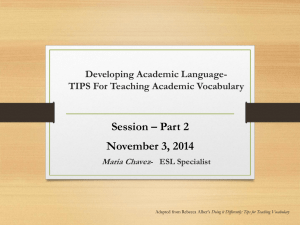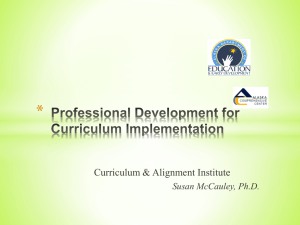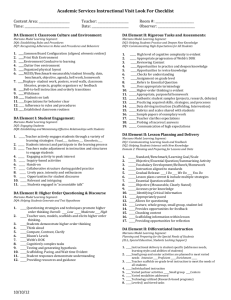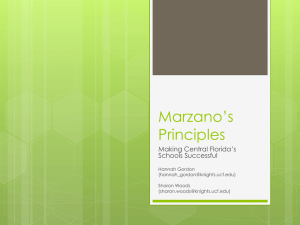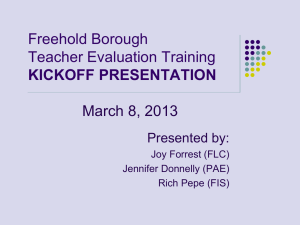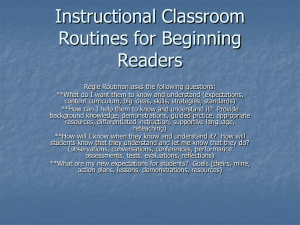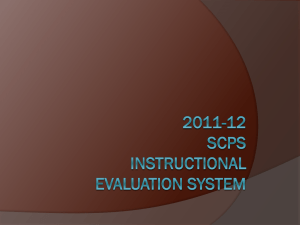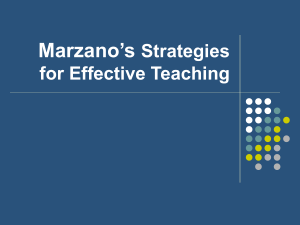Dr. Robert J. Marzano - Video Clips
advertisement
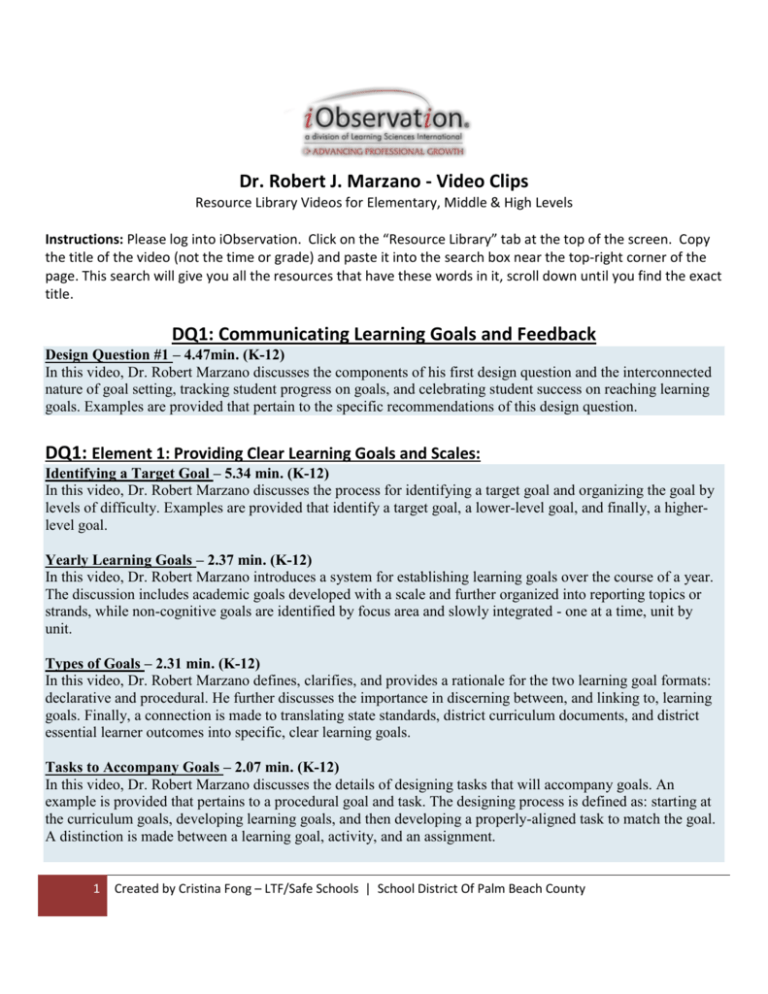
Dr. Robert J. Marzano - Video Clips Resource Library Videos for Elementary, Middle & High Levels Instructions: Please log into iObservation. Click on the “Resource Library” tab at the top of the screen. Copy the title of the video (not the time or grade) and paste it into the search box near the top-right corner of the page. This search will give you all the resources that have these words in it, scroll down until you find the exact title. DQ1: Communicating Learning Goals and Feedback Design Question #1 – 4.47min. (K-12) In this video, Dr. Robert Marzano discusses the components of his first design question and the interconnected nature of goal setting, tracking student progress on goals, and celebrating student success on reaching learning goals. Examples are provided that pertain to the specific recommendations of this design question. DQ1: Element 1: Providing Clear Learning Goals and Scales: Identifying a Target Goal – 5.34 min. (K-12) In this video, Dr. Robert Marzano discusses the process for identifying a target goal and organizing the goal by levels of difficulty. Examples are provided that identify a target goal, a lower-level goal, and finally, a higherlevel goal. Yearly Learning Goals – 2.37 min. (K-12) In this video, Dr. Robert Marzano introduces a system for establishing learning goals over the course of a year. The discussion includes academic goals developed with a scale and further organized into reporting topics or strands, while non-cognitive goals are identified by focus area and slowly integrated - one at a time, unit by unit. Types of Goals – 2.31 min. (K-12) In this video, Dr. Robert Marzano defines, clarifies, and provides a rationale for the two learning goal formats: declarative and procedural. He further discusses the importance in discerning between, and linking to, learning goals. Finally, a connection is made to translating state standards, district curriculum documents, and district essential learner outcomes into specific, clear learning goals. Tasks to Accompany Goals – 2.07 min. (K-12) In this video, Dr. Robert Marzano discusses the details of designing tasks that will accompany goals. An example is provided that pertains to a procedural goal and task. The designing process is defined as: starting at the curriculum goals, developing learning goals, and then developing a properly-aligned task to match the goal. A distinction is made between a learning goal, activity, and an assignment. 1 Created by Cristina Fong – LTF/Safe Schools | School District Of Palm Beach County Dimensions and Types of Learning Goals – 4.07 min. (K-12) In this video, Dr. Robert Marzano discusses the research and theory of setting learning goals. This includes the dimensions or characteristics of goal specificity and goal difficulty, as well as identifying the types of learning goals, including mastery, performance, and non-cognitive goals. Research on Cooperative Learning and Noncognitive Goals – 3.00 min. (K-12) In this video, Dr. Robert Marzano discusses the research and theory behind the connection between cooperative learning and noncognitive goals. He further clarifies that well-designed cooperative goal structures will enable and enhance academic goals, while not replacing individual goals and personal accountability. Unit Level Goals – 5.07 min. (K-12) In this video, Dr. Robert Marzano introduces a system for establishing learning goals within a unit. In classrooms organized around learning goals and scales, students can start out at a lower score in a preassessment, but improve their score as they build their understanding; this is because the score represents a student's status at one point in time, only. Based upon the tracking of their score, students eventually take the initiative to take control of how they demonstrate mastery over the material. Organizing a Scale – 6.15min. (K-12) In this video, Dr. Robert Marzano discusses the process of organizing learning goals into a scale, starting with the development of a target goal scored at a 3.0, then developing a simpler goal for 2.0 and a more complex goal for 4.0. Competency levels for 1.0 and 0.0 are also discussed. The Need for a New Scale – 6.08 min. (K-12) In this video, Dr. Robert Marzano discusses the need for a new scale. He identifies issues with the continued use of the 100 point scale, especially in regard to scoring noncognitive goals. Further discussion includes specific comparison between the 100 point scale and a five point scale and the benefits of transitioning to the new scale through the creation of rubrics. Student Friendly Scales – 2.52 min. (K-12) In this video, Dr. Robert Marzano discusses the merit and value of transitioning a scale into student friendly language. He explains how the teacher facilitates the student development of a rubric they can understand and use. The students become more confident in their ability to learn the content; they are more responsible for, and take ownership of, their own work based upon the scale levels. Protocol Video:Providing Clear Learning Goals and Scales – 2.44 min. (K-5) In this video, Dr. Marzano introduces and discusses the lesson segment involving routine events with specific attention to providing clear learning goals and scales. Protocol Video:Providing Clear Learning Goals (Social Studies) – 2.55 min. (K-5) In this observation and feedback protocol video, Dr. Robert Marzano introduces and reflects upon the lesson segment involving routine events, with a specific focus on providing clear learning goals. This video takes place in a elementary social studies classroom. 2 Created by Cristina Fong – LTF/Safe Schools | School District Of Palm Beach County Protocol Video:Providing Clear Learning Goals (Mathematics) – 1.30 min (middle sch) In this observation and feedback protocol video, Dr. Robert Marzano introduces and reflects upon the lesson segment involving routine events, with a specific focus on clear learning goals. This video takes place in a middle school mathematics classroom. Protocol Video:Providing Clear Learning Goals (Dance 1) – 3.22 min. (H.S.) In this observation and feedback protocol video, Dr. Robert Marzano introduces and reflects upon the lesson segment involving routine events, with a specific focus on clear learning goals. This video takes place in a high school science classroom. Protocol Video:Providing Clear Learning Goals (Dance 2) – 2.29min (H.S.) In this observation and feedback protocol video, Dr. Robert Marzano introduces and reflects upon the lesson segment involving routine events, with a specific focus on clear learning goals. This video takes place in a high school dance classroom. DQ1: Element 2: Track Student Progress: Research Findings on Assessment – 3.43 min. (K-12) In this video, Dr. Robert Marzano discusses the research and theory focused on assessment. He discusses the categories of research on assessment based upon frequency, general effects, and feedback to teachers. He delves into the increased use of formative assessment and identifies the imprecision of any assessment, in that a level of error is always present. Assessment and Teacher Performance – 1.02 min. (K-12) In this video, Dr. Robert Marzano clarifies that the basic purpose of assessment is to change behavior. That stated, he expands the discussion to include changing behavior beyond the students, to the teacher. When done well, assessment should inform the student, but more importantly, inform the teacher about what is working, what is not, and how to generate a plan of action to obtain the desired changes. Types of Assessments – 2.43 min. (K-12) In this video, Dr. Robert Marzano identifies three different types of assessment: obtrusive, unobtrusive, and student generated. He explains that all instruction stops during obtrusive assessment, while during unobtrusive assessment the normal flow of the activity is not interrupted. Finally, a student generated assessment the most underused assessment, requires the most upfront planning, but has the potential to be transformational in a classroom. Summative vs. Formative Score – 5.52 min. (K-12) In this video, Dr. Robert Marzano defines and delineates between summative and formative assessment and summative and formative scores. He explains that, technically, there is no such thing as a formative assessment, since formative scores should never be averaged to produce a final summative score. He clarifies that a true summative score should reflect a teacher's overall judgment of a student's performance level. Finally, he compares and contrasts formative scores to instructional feedback. 3 Created by Cristina Fong – LTF/Safe Schools | School District Of Palm Beach County Selected Response and Short Constructed Response – 4.34 min. (K-12) In this video, Dr. Robert Marzano discusses transferring a scale into selected response and short constructed response items. He goes into detail on how to design assessment items based on the five point scale, considering each item and where it fits on level 2, 3, and 4 of the scale (the simpler content level 2, more complex (targeted) content level 3, and the application for level 4). Extended Constructed Response and Demonstrations – 6.43 min. (K-12) In this video, Dr. Robert Marzano discusses transferring a scale into extended selected response and demonstration items. While on the surface it is very similar to selected and short constructed response, this is very detailed and structured in alignment with the levels of the scale. Marzano explores designing scales for obtrusive assessment types, such as: oral responses, formal oral reports, probing questions, demonstrations, and unobtrusive and student generated assessments. Finally, special education services and needs are explored in light of the new scale. Grading – 5.34 min. (K-12) In this video, Dr. Robert Marzano introduces a nontraditional grading system. Details are included for converting learning goals into traditional goals. In this nontraditional system, grades at the end of the year demonstrate cumulative learning and encourage students to keep learning. This system allows students to master a learning goal after the fact; for example, in a subsequent unit where the information may have been demonstrated or by learning in a different context. Research Findings on Grading – 5.17 min. (K-12) In this video, Dr. Robert Marzano discusses the research and theory focused on grading. He makes a strong case that current grading practices simply do not work well, and never have. He goes on to discuss that, in this age of accountability, grades really need to represent what students know and what they don't know. Grading and Reporting – 10.35 min. (K-12) In this video, Dr. Robert Marzano discusses the difficultly of translating student achievement into an overall score. Details include averaging across learning goals to reach a summative score, the specific scoring for the continual improvement approach, the conjunction approach, translating into advanced, proficient, basic, and below basic, and finally, translating into a percentage Standard-referenced vs. Standard-based Approaches – 8.34 min. (K-12) In this video, Dr. Robert Marzano discusses the differences between and challenges and benefits of the standard-referenced and standard-based approaches. Discussion will focus on how a true standard-based approach has profound implications for changing how the education system looks, sounds, feels, and functions Standard-based in Action – 5.36 min. (K-12) In this video, Dr. Roberta Selleck superintendent at Bucks County School District 50 in Colorado discusses her district's movement and commitment to a standard-based system. School year 2009/2010 is the pilot year for implementing the SBS, and the discussion will focus on the profound implications regarding how the Bucks County education system looks, sounds, feels, and functions. 4 Created by Cristina Fong – LTF/Safe Schools | School District Of Palm Beach County Approach 1:Summative Score Assigned at the End of Grading Period – 5.10 min. (K-12) In this video, Dr. Robert Marzano discusses the first of four tracking methods, titled Summative Score Assigned at the End of a Grading Period. Details of the process for how to track student progress are discussed, and include record reporting suggestions. This tracking process is designed to be used with alignment between learning goals, tasks, and scales. Approach 2:Gradual Accumulation of a Summative Score – 4.39 min. (K-12) In this video, Dr. Robert Marzano discusses the second of four tracking methods, Gradual Accumulation of a Summative Score. This is often referenced as a system that puts students at the heart of the assessment process. Details of the process for how to track student progress are discussed, and include record reporting suggestions. This tracking process is designed to be used with alignment between learning goals, tasks, and scales. Approach 3:The Whole Class Progresses as One – 2.46 min. (K-12) In this video, Dr. Robert Marzano discusses the third of four tracking methods, The Whole Class Progresses as One; as would be expected here, it focuses on the entire class as a single unit. Details of the process for how to track student progress are discussed, and include record reporting suggestions. This tracking process is designed to be used with alignment between learning goals, tasks, and scales. Approach 4:Continual Improvement Throughout the Year – 4.52 min. (K-12) In this video, Dr. Robert Marzano discusses the fourth of four tracking methods, Continual Improvement Throughout the Year. This system allows students to increase their scores on any topic throughout the year. Details of the process for how to track student progress are discussed, and include record reporting suggestions. This tracking process is designed to be used with alignment between learning goals, tasks, and scales. Teacher Perspective:Formative Assessment in Elementary Mathematics – 2.35 min. (K-5) In this video, a classroom teacher shares her perspective on formative assessment, as implemented in her elementary-level mathematics class. This video identifies techniques for generating, evidences of, and new perspectives on formative assessment. Take specific note of how the teacher offers a specific example from her class and targeted advice on formative assessment. Teacher Perspective:Formative Assessment in Elementary Language Arts – 3.35 min. (K-5) In this video, a classroom teacher shares his perspective on formative assessment, as implemented in his elementary language arts class. This video identifies techniques for generating, evidences of, and new perspectives on formative assessment. Take specific note of how the teacher offers a specific example from his class and targeted advice on formative assessment. Teacher Perspective:Formative Assessment in Elementary Language Arts – 0.59 min. (K-5) In this video, a classroom teacher shares her perspective on formative assessment, as implemented in her elementary language arts class. This video identifies techniques for generating, evidences of, and new perspectives on formative assessment. Take specific note of how the teacher offers a specific example from her class and targeted advice on formative assessment. 5 Created by Cristina Fong – LTF/Safe Schools | School District Of Palm Beach County Teacher Perspective:Standard Based System in Elementary Language Arts – 3.01 min. (K-5) In this video, a classroom teacher shares her perspective on a standard based system, as implemented in her elementary language arts class. This video identifies the rationale for, and the challenges and benefits of, moving to a standard based system. Take specific note of how the teacher offers targeted advice. Teacher Perspective:Standard Based System vs. 100 Point Scale – 2.59 min. (K-5) In this video, a classroom teacher shares his perspective on a standard based system, as implemented in his elementary language arts class. This video identifies the misconceptions related to a standard based system and using a 100 point scoring scale, the need to move to a 5 point scale, and the benefits of such a scoring scale. Take specific note of how the teacher offers a specific example from his class and targeted advice. Teacher Perspective:Standard Based System in Elementary Mathematics – 2.53 min. (K-5) In this video, a classroom teacher shares her perspective on a standard based system, as implemented in her elementary mathematics class. This video identifies the rationale for, and the challenges and benefits of, moving to a standard based system. Take specific note of how the teacher offers targeted advice. Protocol Video:Tracking Student Progress (Fourth Grade) – 5.25min. (K-5) In this video, Dr. Marzano introduces and discusses the lesson segment involving routine events with specific attention to tracking student progress. Protocol Video:Tracking Student Progress (Social Studies) – 2.34 min. (K-5) In this observation and feedback protocol video, Dr. Robert Marzano introduces and reflects upon the lesson segment involving routine events, with a specific focus on tracking student progress. This video takes place in a elementary social studies classroom. Teacher Perspective:Standard Based System in Middle School Language Arts – 2.59 min (middle sch) In this video, a classroom teacher shares her perspective on a standard based system, as implemented in her middle school level language arts class. This video identifies the rationale for, and the challenges and benefits of, moving to a standard based system. Take specific note of how the teacher offers targeted advice Protocol Video:Tracking Student Progress (Dance) - 2.02min. (H.S.) In this observation and feedback protocol video, Dr. Robert Marzano introduces and reflects upon the lesson segment that involves routine events, with a specific focus on tracking student progress. This video takes place in a high school dance classroom. DQ1: Element 3: Celebrating Success Research Findings on Feedback – 1.34 min. (K-12) In this video, Dr. Robert Marzano discusses the research and theory focused on feedback. He discusses the definition and compelling evidence that indicates that effective feedback results in twice the effect size, as compared to typical education innovations. 6 Created by Cristina Fong – LTF/Safe Schools | School District Of Palm Beach County Research on Communicating Goals and Providing Feedback – 4.24 min. (K-12) In this video, Dr. Robert Marzano discusses the research and theory behind the connection between communicating goals and providing feedback. Feedback and goal setting are clearly identified as complimentary processes that are not effective in isolation. Further discussion delineates the implications of the specific types of feedback: task, process, self-regulation, and self. Protocol Video:Celebrating Student Success (Fourth Grade) – 3.00 min. (K-5) In this video, Dr. Marzano introduces and discusses the lesson segment involving routine events with specific attention to celebrating student success. Protocol Video:Celebrating Student Success (Dance) – 1.59min. (H.S.) In this observation and feedback protocol video, Dr. Robert Marzano introduces and reflects upon the lesson segment involving routine events, with a specific focus on celebrating student success. This video takes place in an high school dance classroom. Protocol Video:Celebrating Student Success (Language Arts) – 5.06 min. (H.S.) In this observation and feedback protocol video, Dr. Robert Marzano introduces and reflects upon the lesson segment involving routine events, with a specific focus on celebrating student success. This video takes place in an high school language arts classroom. DQ2: Helping Students Interact with New Knowledge Design Question #2 – 5.10 min. (K-12) In this video, Dr. Robert Marzano discusses the components of his second design question, which includes students constructing knowledge while interacting with content. Examples are provided that pertain to the specific recommendations of this design question. DQ2: Element 6: Identifying Critical Information Protocol Video:Identifying Critical Information (Fifth Grade) – 4.39 min. (K-5) In this video, Dr. Marzano introduces and discusses the lesson segment addressing content with specific attention to identifying critical information. Protocol Video:Identifying Critical Information (Kindergarten) – 2.00 min. (K-5) In this video, Dr. Marzano introduces and discusses the lesson segment addressing content with specific attention to identifying critical information. Protocol Video:Identifying Critical Information (Ninth Grade) – 3.47 min. (9th grd) In this video, Dr. Marzano introduces and discusses the lesson segment addressing content with specific attention to identifying critical information. 7 Created by Cristina Fong – LTF/Safe Schools | School District Of Palm Beach County DQ2: Element 7: Organizing Students to Interact with New Knowledge Protocol Video:Organizing Students to Interact with New Knowledge (Fifth Grade) – 3.44 min. (K-5) In this video, Dr. Marzano introduces and discusses the lesson segment addressing content with specific attention to organizing students to interact with new knowledge. Protocol Video:Organizing Students to Interact with New Knowledge (Seventh Grade) – 3.18min(mid sh) In this video, Dr. Marzano introduces and discusses the lesson segment addressing content with specific attention to organizing students to interact with new knowledge. DQ2: Element 8: Previewing New Content Protocol Video:Previewing New Content (Social Studies) – 1.59 min. (K-5) In this observation and feedback protocol video, Dr. Robert Marzano introduces and reflects upon the lesson segment that addresses content, with a specific focus on previewing new content. This video takes place in a elementary social studies classroom. Protocol Video:Previewing New Content (Second Grade) – 4.03 min. (K-5) In this video, Dr. Marzano introduces and discusses the lesson segment addressing content with specific attention to organizing students to previewing new content. Protocol Video:Previewing New Content (Ninth Grade) – 4.32 min (9th grd) In this video, Dr. Marzano introduces and discusses the lesson segment addressing content with specific attention to organizing students to previewing new content. DQ2: Element 9: Chunking Content into “Digestible Bites” Protocol Video:Chunking Content (Fourth Grade) – 4.22 min. (K-5) In this video, Dr. Marzano introduces and discusses the lesson segment addressing content with specific attention to chunking content into digestible bites. Protocol Video:Chunking Content (Ninth Grade) – 3.22 min. (9th grd) In this video, Dr. Marzano introduces and discusses the lesson segment addressing content with specific attention to chunking content into digestible bites. DQ2: Element 10: Processing of New Information Protocol Video:Group Processing of New Information (Fifth Grade - 2) – 3.55 min. (K-5) In this video, Dr. Marzano introduces and discusses the lesson segment addressing content with specific attention to group processing of new information Protocol Video:Group Processing of New Information (Fifth Grade) – 3.39 min. (K-5) *(same as DQ2/7) In this video, Dr. Marzano introduces and discusses the lesson segment addressing content with specific attention to group processing of new information 8 Created by Cristina Fong – LTF/Safe Schools | School District Of Palm Beach County Protocol Video:Group Processing of New Information (Seventh Grade 2) - 3.13 min (7th grade) In this video, Dr. Marzano introduces and discusses the lesson segment addressing content with specific attention to group processing of new information. Protocol Video:Group Processing of New Information (Seventh Grade) - 2.59 min (7th grade) In this video, Dr. Marzano introduces and discusses the lesson segment addressing content with specific attention to group processing of new information. Protocol Video:Group Processing of New Information (Ninth Grade) – 4.55 min. (9th grd) In this video, Dr. Marzano introduces and discusses the lesson segment addressing content with specific attention to group processing of new information. DQ2: Element 11: Elaborating on New Information Protocol Video:Elaborating on New Information (Kindergarten) – 3.00 min. (K-5) In this video, Dr. Marzano introduces and discusses the lesson segment addressing content with specific attention to elaborating on new information. Protocol Video:Elaborating on New Information (Seventh Grade) – 3.36min (7th grade) In this video, Dr. Marzano introduces and discusses the lesson segment addressing content with specific attention to elaborating on new information. Protocol Video:Elaborating on New Information (Ninth Grade) – 4.06min. (9th grd) In this video, Dr. Marzano introduces and discusses the lesson segment addressing content with specific attention to elaborating on new information. DQ2: Element 12: Recording and Representing Knowledge Protocol Video:Recording and Representing Knowledge (Fifth Grade) – 3.28 min. (actually 7th grd) In this video, Dr. Marzano introduces and discusses the lesson segment addressing content with specific attention to recording and representing knowledge. Protocol Video:Recording and Representing Knowledge (Seventh Grade) - 4.01 min (actually 5th grd) In this video, Dr. Marzano introduces and discusses the lesson segment addressing content with specific attention to recording and representing knowledge. Protocol Video:Recording and Representing Knowledge (Ninth Grade) – 3.29min. (9th grd) In this video, Dr. Marzano introduces and discusses the lesson segment addressing content with specific attention to recording and representing knowledge. 9 Created by Cristina Fong – LTF/Safe Schools | School District Of Palm Beach County DQ2: Element 13: Reflecting on Learning Protocol Video:Reflecting on Learning (Kindergarten) – 3.48 min. (K-5) In this video, Dr. Marzano introduces and discusses the lesson segment addressing content with specific attention to reflecting on learning. DQ3: Helping Students Practice and Deepen New Knowledge Design Question #3 – 4.30 min. (K-12) In this video, Dr. Robert Marzano discusses the components of his third design question and the four areas that relate to practice and the deepening of knowledge. Examples are provided that pertain to the specific recommendations of this design question. DQ3: Element 14: Reviewing Content Protocol Video:Reviewing Content (Seventh Grade) – 4.27 min (7th grade) In this video, Dr. Marzano introduces and discusses the lesson segment addressing content with specific attention to reviewing content. Protocol Video:Reviewing Content (Language Arts) – 3.05min. (H.S.) In this observation and feedback protocol video, Dr. Robert Marzano introduces and reflects upon the lesson segment that addresses content, with a specific focus on reviewing content. This video takes place in a high school language arts classroom. DQ3: Element 15: Organizing Students to Practice and Deepen Knowledge Protocol Video:Organizing Students to Practice and Deepen Knowledge – 3.46 min. (K-5) In this video, Dr. Marzano introduces and discusses the lesson segment addressing content with specific attention to organizing students to practice and deepen knowledge DQ3: Element 16: Using Homework Protocol Video:Using Homework (Kindergarten) – 2.02 min. (K-5) In this video, Dr. Marzano introduces and discusses the lesson segment addressing content with specific attention to using homework. Protocol Video:Using Homework (Dance) – 2.44min. (H.S.) In this observation and feedback protocol video, Dr. Robert Marzano introduces and reflects upon the lesson segment that addresses content, with a specific focus on homework. This video takes place in an high school dance classroom. Protocol Video:Using Homework (Science) – 3.36min. (H.S.) In this observation and feedback protocol video, Dr. Robert Marzano introduces and reflects upon the lesson segment that addresses content, with a specific focus on homework. This video takes place in a high school science classroom. 10 Created by Cristina Fong – LTF/Safe Schools | School District Of Palm Beach County DQ3: Element 17: Examining Similarities and Differences Protocol Video:Examining Similarities and Differences (Social Studies) – 4.49 min. (K-5) In this observation and feedback protocol video, Dr. Robert Marzano introduces and reflects upon the lesson segment that addresses content, with a specific focus on examining similarities and differences. This video takes place in an elementary social studies classroom. Protocol Video:Examining Similarities and Differences (Seventh Grade) – 5.18 min (7th grade) In this video, Dr. Marzano introduces and discusses the lesson segment addressing content with specific attention to examining similarities and differences. Protocol Video:Examining Similarities and Differences (Science) – 5.25min (H.S.) In this observation and feedback protocol video, Dr. Robert Marzano introduces and reflects upon the lesson segment that addresses content, with a specific focus on examining similarities and differences. This video takes place in a high school science classroom. DQ3: Element 18: Examining Errors in Reasoning Protocol Video:Examining Errors in Reasoning (Fifth Grade) – 5.01 min. (K-5) In this video, Dr. Marzano introduces and discusses the lesson segment addressing content with specific attention to examining errors in reasoning. Protocol Video:Examining Errors in Reasoning (Mathematics) – 5.23 min (middle sch) In this observation and feedback protocol video, Dr. Robert Marzano introduces and reflects upon the lesson segment that addresses content, with a specific focus on examining errors in reasoning. This video takes place in a middle school mathematics classroom. DQ3: Element 19: Practicing Skills, Strategies, and Processes Protocol Video:Practicing Skills, Strategies and Processes (Fourth Grade) – 5.00 min. (K-5) In this video, Dr. Marzano introduces and discusses the lesson segment addressing content with specific attention to practicing skills, strategies, and processes. Protocol Video:Practicing Skills, Strategies, and Processes (Mathematics) – 4.01 min. (middle sch) In this observation and feedback protocol video, Dr. Robert Marzano introduces and reflects upon the lesson segment that addresses content, with a specific focus on practicing skills, strategies, and processes. This video takes place in a middle school mathematics classroom. Protocol Video:Practicing Skills, Strategies, and Processes (Dance) – 2.47min. (H.S.) In this observation and feedback protocol video, Dr. Robert Marzano introduces and reflects upon the lesson segment that addresses content, with a specific focus on practicing skills, strategies, and processes. This video takes place in a high school dance classroom. 11 Created by Cristina Fong – LTF/Safe Schools | School District Of Palm Beach County DQ4: Helping Students Generate and Test Hypotheses Design Question #4 – 5.24 min. (K-12) In this video, Dr. Robert Marzano discusses the components of his fourth design question and the four types of activities that promote hypothesis-generating and testing. Examples are provided that pertain to the specific recommendations of this design question. DQ4: Element 21: Organizing Students for cognitively Complex Tasks Protocol Video:Organizing Students for Cognitively Complex Tasks (Seventh Grade) – 2.50 min. (7th gr) In this video, Dr. Marzano introduces and discusses the lesson segment addressing content with specific attention to organizing students for cognitively complex tasks. Protocol Video:Organizing Students for Cognitively Complex Tasks – 3.32 min (H.S.) In this video, Dr. Marzano introduces and discusses the lesson segment addressing content with specific attention to organizing students for cognitively complex tasks. DQ4: Element 22: Engaging Students in Cognitively Complex Tasks Involving Hypothesis Generation and Testing Protocol Video:Engaging Students in Cognitively Complex Tasks Involving Hypotheses Generation and Testing – 5.23 min (middle sch) In this video, Dr. Marzano introduces and discusses the lesson segment addressing content with specific attention to engage students in cognitively complex tasks involving hypotheses generation and testing. DQ4: Element 23: Providing Resources and Guidance Protocol Video:Providing Resources and Guidance (Third Grade) – 4.06 min. (K-5) In this video, Dr. Marzano introduces and discusses the lesson segment addressing content with specific attention to providing resources and guidance. Protocol Video:Providing Resources and Guidance (Social Studies) – 6.17 min. (K-5) In this observation and feedback protocol video, Dr. Robert Marzano introduces and reflects upon the lesson segment that addresses content, with a specific focus on providing resources and guidance. This video takes place in a elementary social studies classroom. DQ5: Engaging Students Design Question #5 – 3.44 min. (K-12) In this video, Dr. Robert Marzano discusses the components of his fifth design question and the strategies that help stimulate students. Examples are provided that pertain to the specific recommendations of this design question. 12 Created by Cristina Fong – LTF/Safe Schools | School District Of Palm Beach County DQ5: Element 25: Using Academic Games Protocol Video:Using Academic Games (First Grade) – 3.21 min. (K-5) In this video, Dr. Marzano introduces and discusses the lesson segment enacted on the spot with specific attention to using academic games. Protocol Video:Using Academic Games (Tenth Grade) – 1.55min. (10th grd) In this video, Dr. Marzano introduces and discusses the lesson segment enacted on the spot with specific attention to using academic games. DQ5: Element 26: Managing Response Rates Protocol Video:Managing Response Rates (Second Grade) – 2.30 min. (K-5) In this video, Dr. Marzano introduces and discusses the lesson segment enacted on the spot with specific attention to managing response rates. Protocol Video:Managing Response Rates (Seventh Grade) - 6.21 min (7th grade) In this video, Dr. Marzano introduces and discusses the lesson segment enacted on the spot with specific attention to managing response rates. Protocol Video:Managing Response Rates (Ninth Grade) – 2.57 min. (9th grade) In this video, Dr. Marzano introduces and discusses the lesson segment enacted on the spot with specific attention to managing response rates. DQ5: Element 27: Using Physical Movement Protocol Video:Using Physical Movement (Fifth Grade) – 5.26 min. (K-5) In this video, Dr. Marzano introduces and discusses the lesson segment enacted on the spot with specific attention to using physical movement. Protocol Video:Using Physical Movement (Seventh Grade) – 3.54 min. (7th grade) In this video, Dr. Marzano introduces and discusses the lesson segment enacted on the spot with specific attention to using physical movement. Protocol Video:Using Physical Movement (Tenth Grade) – 2.55 min. (10th grd) In this video, Dr. Marzano introduces and discusses the lesson segment enacted on the spot with specific attention to using physical movement. DQ5: Element 29: Demonstrating Intensity and Enthusiasm Protocol Video:Demonstrating Intensity and Enthusiasm (Second Grade) – 3.49 min. (K-5) In this video, Dr. Marzano introduces and discusses the lesson segment enacted on the spot with specific attention to demonstrating intensity and enthusiasm. Protocol Video:Demonstrating Intensity and Enthusiasm (Fourth Grade) – 4.25 min. (K-5) In this video, Dr. Marzano introduces and discusses the lesson segment enacted on the spot with specific attention to demonstrating intensity and enthusiasm. 13 Created by Cristina Fong – LTF/Safe Schools | School District Of Palm Beach County Protocol Video:Demonstrating Intensity and Enthusiasm (Ninth Grade 2) – 3.54min. (9th grd) In this video, Dr. Marzano introduces and discusses the lesson segment enacted on the spot with specific attention to demonstrating intensity and enthusiasm. Protocol Video:Demonstrating Intensity and Enthusiasm (Ninth Grade 1) – 2.09min. (9th grd) In this video, Dr. Marzano introduces and discusses the lesson segment enacted on the spot with specific attention to demonstrating intensity and enthusiasm. DQ5: Element 30: Using Friendly Controversy Protocol Video:Using Friendly Controversy (Third Grade) – 5.15 min. (K-5) In this video, Dr. Marzano introduces and discusses the lesson segment enacted on the spot with specific attention to using friendly controversy. Protocol Video:Using Friendly Controversy (Seventh Grade) – 5.33 min (7th grade) In this video, Dr. Marzano introduces and discusses the lesson segment enacted on the spot with specific attention to using friendly controversy. DQ5: Element 32: Presenting Unusual or Intriguing Information Protocol Video:Presenting Unusual or Intriguing Information – 2.42 min. (K-12) In this video, Dr. Marzano introduces and discusses the lesson segment enacted on the spot with specific attention to presenting unusual or intriguing information. Protocol Video:Presenting Unusual or Intriguing Information (Third Grade) – 5.01 min. (K-5) In this video, Dr. Marzano introduces and discusses the lesson segment enacted on the spot with specific attention to presenting unusual or intriguing information. Protocol Video:Presenting Unusual or Intriguing Information (Tenth Grade) – 6.39 min. (10th grd) In this video, Dr. Marzano introduces and discusses the lesson segment enacted on the spot with specific attention to presenting unusual or intriguing information. DQ6: Establishing Rules and Procedures Design Question #6 – 2.30 min. (K-12) In this video, Dr. Robert Marzano discusses the components of his sixth design question and the three critical aspects of classroom management. Examples are provided that pertain to the specific recommendations of this design question. 14 Created by Cristina Fong – LTF/Safe Schools | School District Of Palm Beach County DQ6: Element 4: Establishing classroom Routines Protocol Video:Establishing Classroom Routines (Fifth Grade) – 5.59 min. (K-5) In this video, Dr. Marzano introduces and discusses the lesson segment involving routine events with specific attention to establishing classroom routines. Protocol Video:Establishing Classroom Routines (Social Studies) – 2.16 min. (K-5) In this observation and feedback protocol video, Dr. Robert Marzano introduces and reflects upon the lesson segment involving routine events, with a specific focus on establishing classroom routines. This video takes place in a elementary social studies classroom. Protocol Video:Establishing Classroom Routines (Mathematics) – 2.23 min. (middle sch) In this observation and feedback protocol video, Dr. Robert Marzano introduces and reflects upon the lesson segment involving routine events, with a specific focus on establishing classroom routines. This video takes place in a middle school mathematics classroom. DQ6: Element 5: Organizing the Physical Layout of the room Organizing the Physical Layout:Student and Teacher Desks – 3.42 (K-12) In this video, Dr. Robert Marzano discusses organizing the physical layout of the classroom with a focus on arrangement of student and teacher desks. Organizing the Physical Layout:Preparing and Organizing Materials – 5.20 min. (K-12) In this video, Dr. Robert Marzano discusses organizing the physical layout of the classroom with a focus on preparing and organizing materials. Organizing the Physical Layout:Decorating to Aid and Reinforce Learning – 3.19 min. (K-12) In this video, Dr. Robert Marzano discusses organizing the physical layout of the classroom with a focus on decorating to aid and reinforce learning. Organizing the Physical Layout:Access and Traffic Patterns – 2.56 min. (K-12) In this video, Dr. Robert Marzano discusses organizing the physical layout of the classroom with a focus on access and traffic patterns. DQ7: Recognizing adherence to Rules and Procedures Design Question #7 – 3.03 min. (K-12) In this video, Dr. Robert Marzano discusses the components of his seventh design question, which is broken into two broad categories that involve acknowledgment of positive and negative behaviors. Examples are provided that pertain to the specific recommendations of this design question. 15 Created by Cristina Fong – LTF/Safe Schools | School District Of Palm Beach County DQ7: Element 33: Demonstrating “Withitness” Acknowledgment of Lack of Adherence Rules and Procedures:Withitness – 5.02 min. (K-5) In this video, Dr. Robert Marzano discusses the management strategy "withitness." Protocol Video:Demonstrating Withitness – 4.05 min. (K-5) In this video, Dr. Marzano introduces and discusses the lesson segment enacted on the spot with specific attention to demonstrating withitness. DQ7: Element 34: Applying consequences for lack of adherence to rules and procedures Applying Consequences for Lack of Adherence to Rules and Procedures – 2.22 min. (K-12) In this video, listen to mulitple teacher perspectives on acknowledging lack of adherence to rules and procedures. Acknowledgment of Lack of Adherence Rules and Procedures:Disciplinary Plan – 4.12 min. (K-12) In this video, Dr. Robert Marzano discusses the importance of designing a disciplinary plan of action. Acknowledgment of Lack of Adherence Rules and Procedures:High Intensity Situations – 5.02 min. In this video, Dr. Robert Marzano discusses identifying and planning for high-intensity situations. (K-12) Acknowledgment of Lack of Adherence Rules and Procedures:Contingency Plans – 6.19 min. (K-12) In this video, Dr. Robert Marzano discusses the purpose and value of contingency plans. Acknowledgment of Lack of Adherence Rules and Procedures:Direct-Cost Consequences – 4.39 min. In this video, Dr. Robert Marzano discusses the direct-cost consequences with specific focus on time-out and overcorrection strategies (K-12) Acknowledgment of Lack of Adherence Rules and Procedures:Withitness – 5.06 min. (K-12) In this video, Dr. Robert Marzano discusses the management strategy "withitness." Protocol Video:Applying Consequences – 3.58 min. (K-5) In this video, Dr. Marzano introduces and discusses the lesson segment enacted on the spot with specific attention to applying consequences for lack of adherence to rules and procedures. DQ7: Element 35: Acknowledging adherence to rules and procedures Rules and Procedures:Interacting, Reviewing, Town Meetings – 5.51 min. (K-12) In this video, Dr. Robert Marzano discusses establishing classroom routines with a focus on interacting and reviewing rules and procedures and facilitating town meetings. Acknowledging Adherence to Rules and Procedures – 2min. (K-12) In this video, listen to multiple teacher perspectives on and benefits of providing verbal and nonverbal recognition. 16 Created by Cristina Fong – LTF/Safe Schools | School District Of Palm Beach County Acknowledgment of Adherence Rules and Procedures:Home Recognition – 4.30 min. (K-12) In this video, Dr. Robert Marzano discusses the purpose and value of building positive connections through home recognition. Acknowledgment of Adherence Rules and Procedures:Tangible Recognition – 3.20 min. (K-12) In this video, Dr. Robert Marzano discusses the value added with tangible recognition. Acknowledgment of Adherence Rules and Procedures:Verbal and Nonverbal Acknowledgement – 3.07 min. (K-12) In this video, Dr. Robert Marzano discusses the importance of verbal and nonverbal positive acknowledgement of adherence to rules and procedures. Rules and Procedures 2 – 2.30 min. (K-12) In this video, listen to the teacher perspective on establishing rules and procedures Rules and Procedures 1 – 7.30 min. (K-12) In this video, Dr. Robert Marzano discusses establishing classroom routines with a focus on rules and procedures. Protocol Video:Acknowledging Adherence to Rules and Procedures – 2.40 min. (K-5) In this video, Dr. Marzano introduces and discusses the lesson segment enacted on the spot with specific attention to applying acknowledging adherence to rules and procedures. DQ8: Establishing and Maintaining Effective Relationships with Students Design Question #8 – 3.15 min. (K-12) In this video, Dr. Robert Marzano discusses the components of his eighth design question and speaks to two behaviors that form the relationship boundaries of dominance and cooperation. Examples are provided that pertain to the specific recommendations of this design question. DQ8: Element 36: Understanding Students’ Interests and Background Protocol Video:Understanding Students' Interests and Background (Fifth Grade) – 3.25 min. (K-5) In this video, Dr. Marzano introduces and discusses the lesson segment enacted on the spot with specific attention to understanding student interest and background. Protocol Video:Using Friendly Controversy (Third Grade) – 5.15 min. (K-5) In this video, Dr. Marzano introduces and discusses the lesson segment enacted on the spot with specific attention to using friendly controversy. Protocol Video:Using Friendly Controversy (Seventh Grade) – 5.33min. (7th grd) In this video, Dr. Marzano introduces and discusses the lesson segment enacted on the spot with specific attention to using friendly controversy. 17 Created by Cristina Fong – LTF/Safe Schools | School District Of Palm Beach County Protocol Video:Understanding Students' Interests and Background (Ninth Grade) – 2.48min. (9th grd) In this video, Dr. Marzano introduces and discusses the lesson segment enacted on the spot with specific attention to understanding student interest and background. Protocol Video:Using Friendly Controversy (Tenth Grade) – 3.28 min. (10th grd) In this video, Dr. Marzano introduces and discusses the lesson segment enacted on the spot with specific attention to using friendly controversy. Protocol Video:Understanding Students' Interests and Background (Eleventh Grade) – 4.27 min(11th gd) In this video, Dr. Marzano introduces and discusses the lesson segment enacted on the spot with specific attention to understanding student interest and background. DQ8: Element 37: Using Verbal and Nonverbal Behaviors that Indicate Affection for Students Protocol Video:Using Verbal and Nonverbal Behaviors that Indicate Affection (Fourth Grade) – 2.43 min. (K-5) In this video, Dr. Marzano introduces and discusses the lesson segment enacted on the spot with specific attention to using verbal and nonverbal behaviors to indicate affection. Protocol Video:Using Verbal and Nonverbal Behaviors that Indicate Affection (Ninth Grade) – 4.09min (9th grd) In this video, Dr. Marzano introduces and discusses the lesson segment enacted on the spot with specific attention to using verbal and nonverbal behaviors to indicate affection. Protocol Video:Using Verbal and Nonverbal Behaviors that Indicate Affection (Tenth Grade) – 2.54min (10th grd) In this video, Dr. Marzano introduces and discusses the lesson segment enacted on the spot with specific attention to using verbal and nonverbal behaviors to indicate affection. DQ9: Communicating high Expectations for All Students Design Question #9 – 3.03min. (K-12) In this video, Dr. Robert Marzano discusses the components of his ninth design question and speaks to the need of teachers to convey high expectations through their words and actions. Examples are provided that pertain to the specific recommendations of this design question. DQ10: Developing Effective lessons Organized into a Cohesive Unit Design Question #10 – 2.38 min. (K-12) In this video, Dr. Robert Marzano discusses his tenth design question, which is different from the other nine questions in that it focuses on planning and organizing a unit of instruction. The three areas of focus when planning are: focus on knowledge, focus on issues, and focus on inquiry. 18 Created by Cristina Fong – LTF/Safe Schools | School District Of Palm Beach County General/FYIs Developmental Scale:Innovating – 1.03 min. (K-12) In this video, Dr. Robert Marzano explains Innovating on the developmental scale. Developmental Scale:Applying – 1.38 min. (K-12) In this video, Dr. Robert Marzano explains Applying on the developmental scale. Developmental Scale:Developing – .54 min. (K-12) In this video, Dr. Robert Marzano explains Developing on the developmental scale. Developmental Scale:Beginning – 2.57 min. (K-12) In this video, Dr. Robert Marzano explains Beginning on the developmental scale. Developmental Scale:Not Using – 3.03 min. (K-12) In this video, Dr. Robert Marzano explains Not Using on the developmental scale. Teacher Evaluation How-To – 7.27 min. (K-12) This video demonstrates using the evaluation module from the teacher point of view. Introduction to New Taxonomy – 3.40 min. (K-12) In this video, Dr. Robert Marzano introduces the criterion for writing learning goals that are challenging but attainable, and the research behind the development of a New Taxonomy based upon the progression from simple to complex thinking. Dr. Marzano identifies the new taxonomy levels of retrieval, comprehension, analysis, and knowledge utilization, and the distinct mental processes associated at each level. Analysis Level of New Taxonomy – 12.42 min. (K-12) In this video, Dr. Robert Marzano discusses the analysis level of the New Taxonomy. The mental processes of matching, classifying, analyzing errors, generalizing, and specifying are discussed, with specific examples of the targeted goal statement and sample task provided. Comprehension Level of New Taxonomy – 5.31 min. (K-12) In this video, Dr. Robert Marzano discusses the comprehension level of the New Taxonomy. The mental processes of integrating and symbolizing are discussed, with specific examples of the targeted goal statement and sample task provided. Knowledge Utilization Level of New Taxonomy 8.25 min. (K-12) In this video, Dr. Robert Marzano discusses the knowledge utilization level of the New Taxonomy. The mental processes of decision making, problem solving, experimenting, and investigating are discussed, with specific examples of the targeted goal statement and sample task provided Retrieval Level of New Taxonomy – 5.36 min. (K-12) In this video, Dr. Robert Marzano expands on the taxonomy as a framework for designing learning goals that progress from simple to complex, with specific attention paid to the lowest level: retrieval. The mental processes of recognizing, recalling, and executing are discussed, with specific examples of the targeted goal statement and sample task provided. 19 Created by Cristina Fong – LTF/Safe Schools | School District Of Palm Beach County Lesson Segments – 6.18 min. (K-12) In this video, Dr. Robert Marzano discusses the reorganization of his 10 design questions into categories of behavior, or lesson segments, that might be observed in a classroom. These lesson segments become not only the framework for designing lessons and units, but also a framework for observing classroom instructional practices. Introducing Lesson Segments – 4.19 min. (K-12) In this video, Dr. Robert Marzano introduces the research on the lesson segment and identifies it as a slice of a lesson. Further discussion explores how the 10 design questions are reorganized into three basis lesson segments. Dr. Marzano identifies the lesson segments as a paradigm for changing how teachers approach and implement instruction. Model or Language of Instruction – 3.56 min. (K-12) In this video, Dr. Robert Marzano discusses the model or language of instruction and the value of a shared language for understanding expertise. Second, the video introduces the research behind the 10 design questions, which are the basis of the art and science of teaching. Finally, Dr. Marzano discusses the value and surprises of ongoing action research in developing the expert teacher. Effective Teachers – 4.45 min. (K-12) In this video, Dr. Robert Marzano discusses the statistical research findings that indicate that the teacher is the single most influential component of an effective school. He furthers the discussion by identifying the characteristics of effective teachers and concludes that any teacher with the desire can reach the expert teacher level through repeated practice and reflection on the art and science of teaching. High Yield Strategies – 2.48 min. (K-12) In this video, Dr. Robert Marzano discusses the terminology of high yield strategies and the implications for classroom teachers and instruction. He presents the evidence-based research behind replacing this terminology with the more appropriate high probability strategies. Dr. Marzano also discusses what is actually meant by the art and science of teaching. Classroom Scenario:Analysis – 6.05 min (elementary) View the classroom scenario video and identify tasks designed for analysis level goals. As you view the classroom scenario video, keep in mind that the mental processes for analysis level goals include matching, classifying, analyzing errors, generalizing, and specifying. Take specific note that the student's task enables them to analyze errors in the meaning of standard Classroom Scenario:Comprehension – 5.13 min. (K-5) View the classroom scenario video and identify tasks designed for comprehension level goals. As you view the classroom scenario video, keep in mind that the mental processes for comprehension level goals include integrating and symbolizing. Take specific note that the student's task included both a written definition in their own words and to produce a symbolic representation of the meaning. As an enhancement, access the asset tool titled, Classroom Scenario Video Review Guide: Comprehension Goals. 20 Created by Cristina Fong – LTF/Safe Schools | School District Of Palm Beach County Classroom Scenario:Retrieval – 3.28 min (middle sch) View the classroom scenario video and identify tasks designed for retrieval level goals. As you view the classroom scenario video, keep in mind that the mental processes for retrieval level goals include recognition, recall, and execution. Take specific note that the mental procedure demonstrated included a multiple choice task. As an enhancement, access the asset tool titled, Classroom Scenario Video Review Guide: Retrieval Goals. Teacher Perspective – 5.10 min. (K-12) In this video, teachers discuss their experience in videotaping their own instructional practice. Teachers share the life-changing effects the analysis of these videotaped lessons have had on their instructional practice, on how they view themselves, and on their effectiveness in the classroom. Practice Video 1 – 4.55min. (K-5) Elementary (Grade Kindergarten) Reading Practice Video 2 – 3.56 min. (K-5) Elementary (Grade 3) Mathematics Practice Video 5 – 3.10 min. (K-5) Elementary (Grade 5) General Education Practice Video 6 – 3.20 min. (K-5) Elementary (Grade 5) General Education Practice Video 7 3.14 min (6th grade) Middle (Grade 6) Social Studies Practice Video 8 2.09 min (7th grade)) Middle (Grade 7) Mathematics Practice Video 9 - 3.45 min. (8th grade) Middle (Grade 8) Physical Science Practice Video 11 - 2.54 min (8th grade) Middle (Grade 8) Physical Science Practice Video 12 – 2.45min. (9th grd) Secondary (Grade 9) American Studies Practice Video 13 – 3.32 min. (9th grd) Secondary (Grades 9) American Studies Practice Video 14 – 2.27 min. (9th grd) Secondary (Grade 9) American Studies 21 Created by Cristina Fong – LTF/Safe Schools | School District Of Palm Beach County Practice Video 15 – 3.31min. (9th grd) Secondary (Grades 9) American Studies Video A – 3:54 min (middle and H.S.) Classroom Visit: Math Video B - 4.00 min (middle school) Classroom Visit 2: Middle School Social Studies Class Video C – 5.31 min (middle school) Classroom Visit 1: Middle School Language Arts Class Video D – 5.55 min (middle school) Classroom Visit 2: Middle School Math Class Video E – 3.15 min (middle school) Classroom Visit 3: Middle School Science Class 22 Created by Cristina Fong – LTF/Safe Schools | School District Of Palm Beach County
